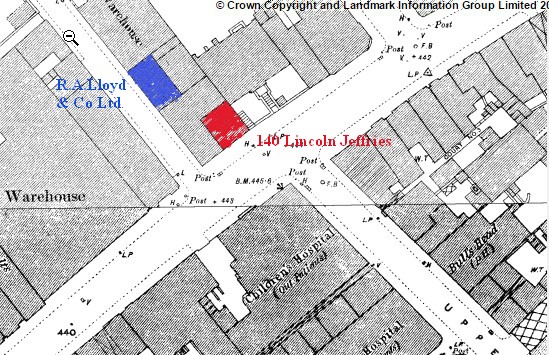Dennis Williams
Gone but not forgotten
Some time ago I recounted a piece on one of the most famous families in Brum’s history, namely the Galtons….here is a snippet with no pics, as they were hacked…
https://birminghamhistory.co.uk/forum/showthread.php?t=34438&highlight=Galtons
And a sort of reprise WITH pics…
https://birminghamhistory.co.uk/for...&page=2&p=466180&highlight=Galtons#post466180
So, to get to the point….despite the fact that they were devote Quakers, Samuel Galton (1720-1799) and his son Samuel John Galton (1753-1832) had a large gun-making factory in Birmingham. When Samuel senior died, his son Samuel John, and grandson, Samuel Tertius Galton (1783-1844) wound up the business and set up a bank in Birmingham instead. Earlier, Sam J had rather fortuitously married a Lucy Barclay of London, whose family was well into Banking. You may have heard of Barclays Bank?. She was perhaps preposterously known as ‘the fair Quakeress’ and reputed to be the illegitimate daughter of a George III and a Hannah Lightfoot. Typical mischievous Daily Mail-like punt I expect...but I digress. Someone may care to track down the ‘truth’ for me. Thanks.
Sam Tertius Galton married Frances Darwin (daughter of Erasmus Darwin), whose family later also included the ‘origin of the species’ chap Charles, and one of them also got mixed in with the Wedgwood pottery lot for extra spice.
The Galton boys were great mates of Priestley, Eramus Darwin, and other prominent members of The LUNAR SOCIETY, who frequently used to meet at Sam Galton’s home GALTON HOUSE in Steelhouse Lane (where the gun factory was).
The Gaumont Cinema later stood on the site of Galton House, and as a tribute to the Lunar Society connections, featured a beautiful ceiling depicting the star spangled heavens, with a central moon and the signs of the zodiac surrounding it.
When he sold the gun making business, he left Steelhouse Lane and moved into Duddeston Hall, “amid scenes of perfect and luxuriant solitude”; where today Galton Street runs down to Duddeston Mill Road alongside the railway marshalling yards. Here, in Sam’s days, “was a four acre lake where flocks of assorted exotic wild fowl would flock to him for feeding when he blew a whistle”. No change there then…
Questions: I have never seen or heard of Galton House in Steelhouse Lane, and would love to see a picture of it? And the gun factory? And the ceiling of the Gaumont, which I went to many times and can only vaguely remember the films I saw, never mind the ceiling…?
Aswer: See photos and Map…courtesy of the Shoothill Treasure Trove!!! …I am finally made up…well tantalizingly close at the very least!!! Both photos are labeled Galton House, and I think they are both ends on the gap where Galton House once stood, see map….I don’t think either look grand enough to be a dwelling of such an important and wealthy man…what does the team think?




https://birminghamhistory.co.uk/forum/showthread.php?t=34438&highlight=Galtons
And a sort of reprise WITH pics…
https://birminghamhistory.co.uk/for...&page=2&p=466180&highlight=Galtons#post466180
So, to get to the point….despite the fact that they were devote Quakers, Samuel Galton (1720-1799) and his son Samuel John Galton (1753-1832) had a large gun-making factory in Birmingham. When Samuel senior died, his son Samuel John, and grandson, Samuel Tertius Galton (1783-1844) wound up the business and set up a bank in Birmingham instead. Earlier, Sam J had rather fortuitously married a Lucy Barclay of London, whose family was well into Banking. You may have heard of Barclays Bank?. She was perhaps preposterously known as ‘the fair Quakeress’ and reputed to be the illegitimate daughter of a George III and a Hannah Lightfoot. Typical mischievous Daily Mail-like punt I expect...but I digress. Someone may care to track down the ‘truth’ for me. Thanks.
Sam Tertius Galton married Frances Darwin (daughter of Erasmus Darwin), whose family later also included the ‘origin of the species’ chap Charles, and one of them also got mixed in with the Wedgwood pottery lot for extra spice.
The Galton boys were great mates of Priestley, Eramus Darwin, and other prominent members of The LUNAR SOCIETY, who frequently used to meet at Sam Galton’s home GALTON HOUSE in Steelhouse Lane (where the gun factory was).
The Gaumont Cinema later stood on the site of Galton House, and as a tribute to the Lunar Society connections, featured a beautiful ceiling depicting the star spangled heavens, with a central moon and the signs of the zodiac surrounding it.
When he sold the gun making business, he left Steelhouse Lane and moved into Duddeston Hall, “amid scenes of perfect and luxuriant solitude”; where today Galton Street runs down to Duddeston Mill Road alongside the railway marshalling yards. Here, in Sam’s days, “was a four acre lake where flocks of assorted exotic wild fowl would flock to him for feeding when he blew a whistle”. No change there then…
Questions: I have never seen or heard of Galton House in Steelhouse Lane, and would love to see a picture of it? And the gun factory? And the ceiling of the Gaumont, which I went to many times and can only vaguely remember the films I saw, never mind the ceiling…?
Aswer: See photos and Map…courtesy of the Shoothill Treasure Trove!!! …I am finally made up…well tantalizingly close at the very least!!! Both photos are labeled Galton House, and I think they are both ends on the gap where Galton House once stood, see map….I don’t think either look grand enough to be a dwelling of such an important and wealthy man…what does the team think?











